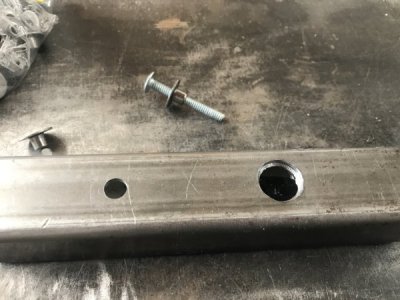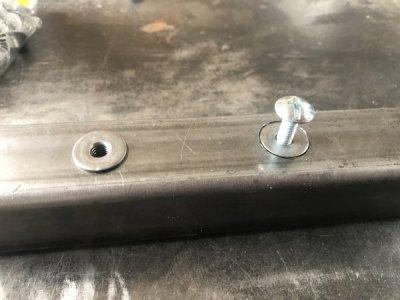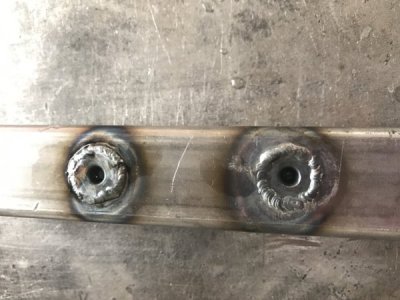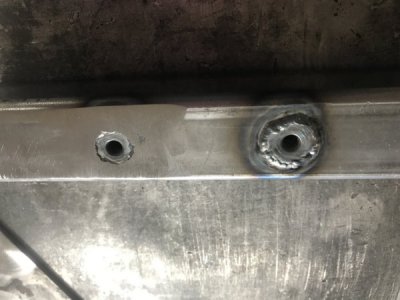- Joined
- Oct 28, 2016
- Messages
- 11
Hi all,
I know this isn't exactly a machining question, but I'd like your point of view!
I make custom metal furniture, and more and more lately, we need very consistent threaded holes. I normally tap by hand, but some projects need more consistency than I can provide. I haven't been able to find machining classes yet, so I thought in the meantime, what would a welder do?
It has been suggested to me to check out threaded inserts, which I could just drop in the hole, weld, and sand the top smooth. Only problem is, the result is kinda ugly, not up to standards for fine furniture for us, and not even as accurate as I wanted. My first attempt was with standard weld nuts from McMaster-Carr that have a little flange. One way I tried was to just weld on the flange, which even if my welds weren't as sloppy, is a little too ugly for what we need. The other way I tried was to countersink the hole to fit the flange-- it ended up being a pain to do on my 1/8" thick steel and much less accurate than I wanted anyway. Didn't even both to sand it smooth all the way because apparently it was hard to keep the flange flush to the metal.
I think I'm going about this problem the wrong way, I need another eye to take a look.
Does anyone know of the kind of threaded insert that would be clean and quick? Do you think I should skip threaded inserts anyway and try threading on the drill press? I've been hesitant to try that out because our drill press is a little wonky- I don't think it is square to its bed and I've noticed the drill doesn't spin 100% centered and tends to slide sometimes while beginning the hole.
Also if anyone knows of basic machining classes in the NYC area, let me know. I try a lot of metalshop things on my own, but I honestly feel afraid to tackle the lathe on my own with Youtube University, but maybe it's not so tough to figure out? What do you think? Any advice is appreciated!
Thanks!




I know this isn't exactly a machining question, but I'd like your point of view!
I make custom metal furniture, and more and more lately, we need very consistent threaded holes. I normally tap by hand, but some projects need more consistency than I can provide. I haven't been able to find machining classes yet, so I thought in the meantime, what would a welder do?
It has been suggested to me to check out threaded inserts, which I could just drop in the hole, weld, and sand the top smooth. Only problem is, the result is kinda ugly, not up to standards for fine furniture for us, and not even as accurate as I wanted. My first attempt was with standard weld nuts from McMaster-Carr that have a little flange. One way I tried was to just weld on the flange, which even if my welds weren't as sloppy, is a little too ugly for what we need. The other way I tried was to countersink the hole to fit the flange-- it ended up being a pain to do on my 1/8" thick steel and much less accurate than I wanted anyway. Didn't even both to sand it smooth all the way because apparently it was hard to keep the flange flush to the metal.
I think I'm going about this problem the wrong way, I need another eye to take a look.
Does anyone know of the kind of threaded insert that would be clean and quick? Do you think I should skip threaded inserts anyway and try threading on the drill press? I've been hesitant to try that out because our drill press is a little wonky- I don't think it is square to its bed and I've noticed the drill doesn't spin 100% centered and tends to slide sometimes while beginning the hole.
Also if anyone knows of basic machining classes in the NYC area, let me know. I try a lot of metalshop things on my own, but I honestly feel afraid to tackle the lathe on my own with Youtube University, but maybe it's not so tough to figure out? What do you think? Any advice is appreciated!
Thanks!





